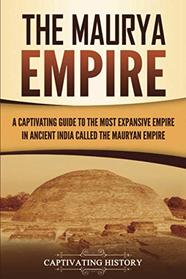The Maurya Empire was an incredibly extensive power that dominated the Indian subcontinent between 322 - 185 BCE. It covered all but the most southern areas of India and lots of modern-day Iran. This empire rose to power during the Iron Age.
Chanakya (the real power) took Chandragupta Maurya under his wing and together, they dismantled the Nanda Dynasty and created the Mauryan Empire, first through warfare, then through political maneuvering, and (good old-fashioned) murder. After Alexander the Great's armies refused to fight in India, returning to Egypt, Chanakya and Chandragupta Maurya took advantage of the power vacuum to attack the Nanda at its weakest.
The first three reigns (of Chandragupta Maurya, Bindusara, and Ashoka) were stable because of the great lengths of each rule. In other words, of the 136-year rule of the Maurya Empire, about 90 of those years were with only 3 rulers. They ruled with equal measures of spying, political strategies, and religious fervor. They sought national harmony through religious tolerance and trust. Interestingly enough, each of the first 3 rulers followed a different religion.
Prior to the Maurya's, petty rulers warred with each other. But a single pan-India dynasty encouraged commerce, trade, economic stability, expansive construction of roads and buildings, and internal peace.
In 185 BCE, the last Mauryan emperor was killed by his own general, Pushyamitra, and he formed the Shunga dynasty. This man was religiously intolerant and reinstituted animal sacrifices and persecuted Buddhist monks. One clever comment in this book: "It is interesting how so many of India's ancient rulers embraced spirituality and asceticism after conquering large swathes of the continent, displacing people, and laying waste to generations." (p. 84)
It is amazing what has been uncovered from such an ancient dynasty by Captivating History. Until reading this, I assumed that the British were the first people to unite the Indians.
Chanakya (the real power) took Chandragupta Maurya under his wing and together, they dismantled the Nanda Dynasty and created the Mauryan Empire, first through warfare, then through political maneuvering, and (good old-fashioned) murder. After Alexander the Great's armies refused to fight in India, returning to Egypt, Chanakya and Chandragupta Maurya took advantage of the power vacuum to attack the Nanda at its weakest.
The first three reigns (of Chandragupta Maurya, Bindusara, and Ashoka) were stable because of the great lengths of each rule. In other words, of the 136-year rule of the Maurya Empire, about 90 of those years were with only 3 rulers. They ruled with equal measures of spying, political strategies, and religious fervor. They sought national harmony through religious tolerance and trust. Interestingly enough, each of the first 3 rulers followed a different religion.
Prior to the Maurya's, petty rulers warred with each other. But a single pan-India dynasty encouraged commerce, trade, economic stability, expansive construction of roads and buildings, and internal peace.
In 185 BCE, the last Mauryan emperor was killed by his own general, Pushyamitra, and he formed the Shunga dynasty. This man was religiously intolerant and reinstituted animal sacrifices and persecuted Buddhist monks. One clever comment in this book: "It is interesting how so many of India's ancient rulers embraced spirituality and asceticism after conquering large swathes of the continent, displacing people, and laying waste to generations." (p. 84)
It is amazing what has been uncovered from such an ancient dynasty by Captivating History. Until reading this, I assumed that the British were the first people to unite the Indians.




